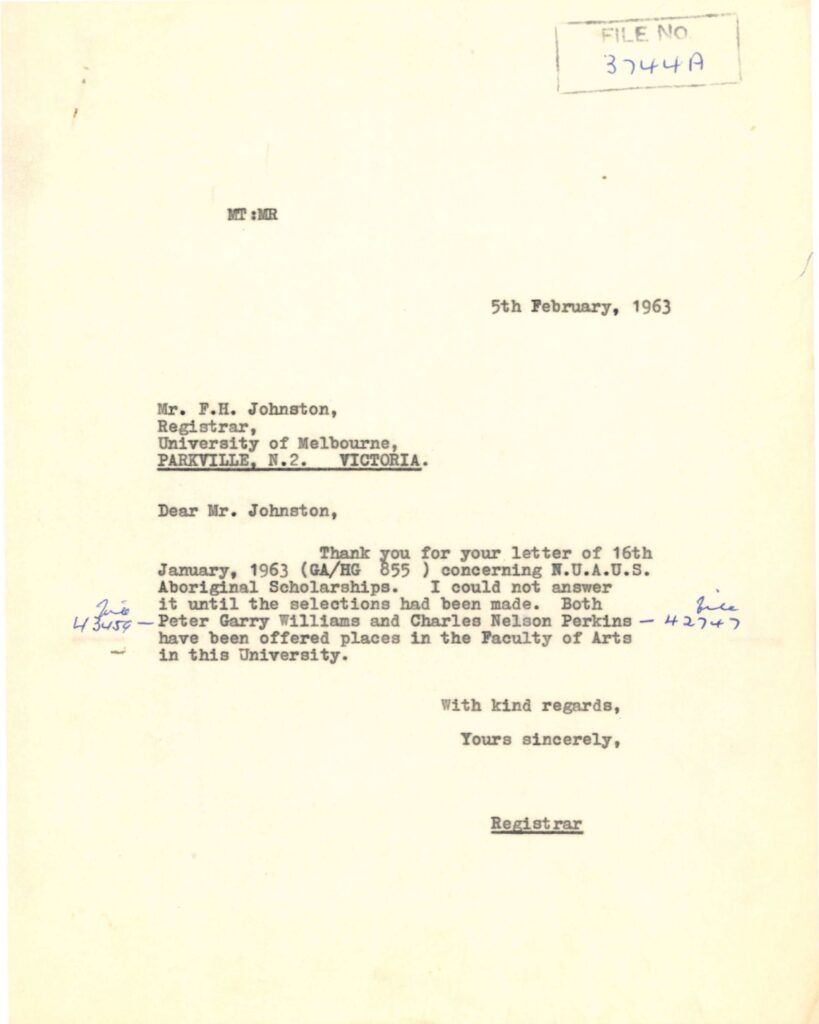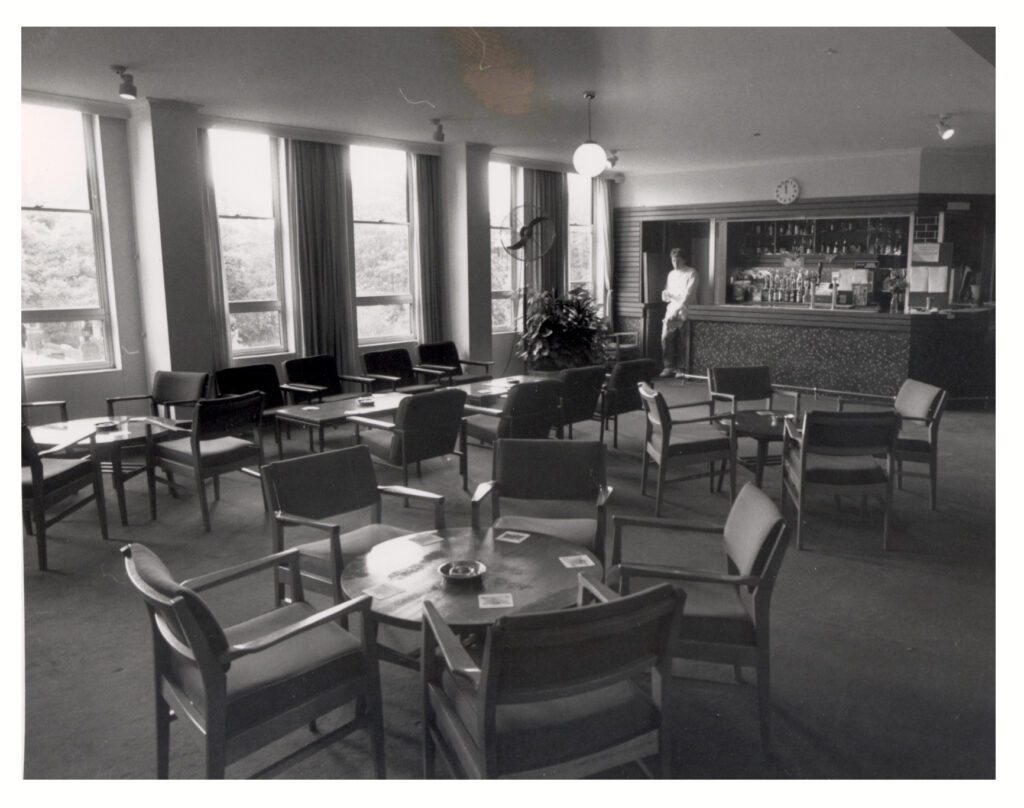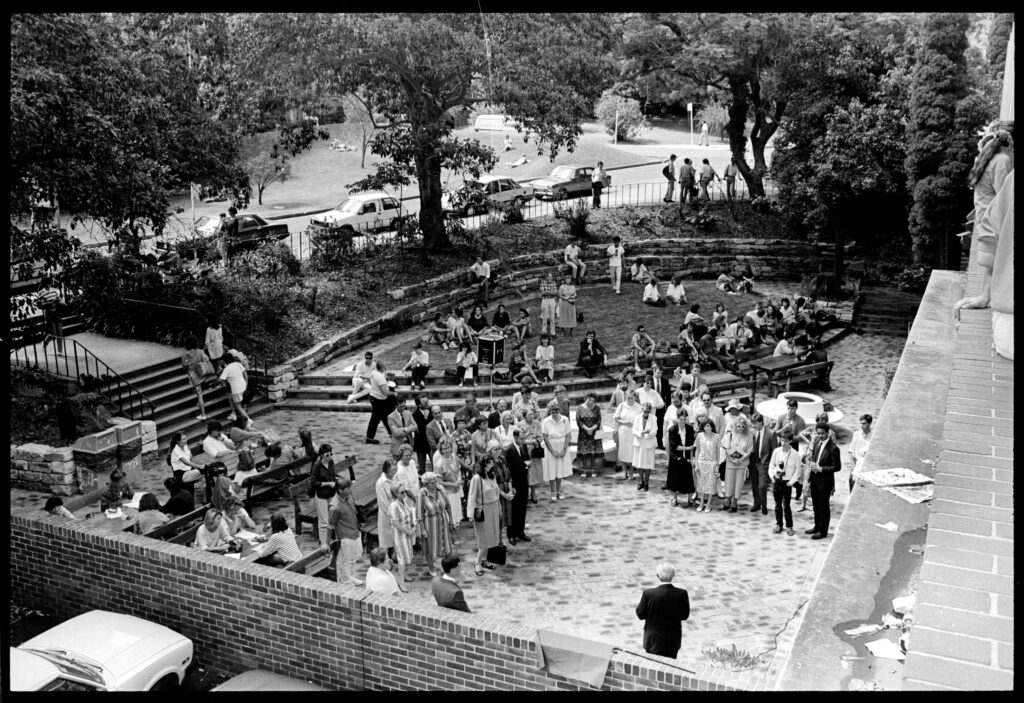The University Archives turns 70 on 3 May this year. To celebrate this milestone, check the blog at the end of each week for the week’s special stories from our collections.

26 February 2024
This item/story includes the names of deceased people, which may cause distress and sadness to First Nations peoples. This item/story also includes content and language, which reflects the attitudes of the historical period in which it was created, and which may be considered discriminatory, insensitive, outdated and/or offensive in today’s context. The item is preserved without alteration as historical evidence.
An Allowance of £100
The National Union of Australian University Students (NUAUS) was established by University of Melbourne students in the early 1950s, with the (draft) regulation, “Whereas the National Union of Australian University Students hereinafter called the said National Union has presented to the University the sum of £1,300 to endow scholarships to assist the entry of Aborigines to Australian Universities with the hope that such scholars use their knowledge for the advancement of their race. And whereas the said National Union desires that if this aim becomes impracticable then the fund should be used for some other purpose related to the education of Aborigines”.
The NUAUS wrote to the University of Sydney on 12 September 1955 seeking approval of a proposal, “In view of the fact that we desire the scholarship to be open for any University, it is necessary for your Council to agree to accept a student who may be selected for a scholarship, and may wish to do his course at your University. Naturally such a student would be required to have the necessary qualifications for any course he may choose…we require the approval of all Universities before the final regulation is accepted”. The University of Sydney accepted the proposal later that month.
This letter confirms that the University of Sydney selected Peter Garry Williams and Charles Nelson Perkins to study within the Faculty of Arts at the University – the first known Indigenous students to study at the University. The Student Advisor, ‘Adviser to Men Students’, Grahame Scarlett, interviewed Perkins and wrote to the University of Melbourne on 22 October 1962, recommending him as a, “…thoroughly worthwhile applicant. Our subjective impression is that he is a very intelligent man who has made a very good adjustment to the racial problem and who is likely to succeed provided that he qualifies for matriculation and gains a place in the quota in the Faculty of Arts in whichever university he chooses to attend”.
In a letter to Scarlett, dated 12 February 1963, the University of Melbourne noted that the scholarship provided, “…an allowance of £100 for books and clothing and £7 per week from 1st February 1963 to 31st December 1963”. Both Perkins and Williams had their scholarships renewed, without formal application, in 1964.
NUAUS Aboriginal Scholarship (1960s), [REF-00038329]. University of Sydney Archives, accessed 26/02/2024, https://archives-search.sydney.edu.au/nodes/view/83563.
27 February 2024
A Room of One’s Own
A circular proposing the establishment of a Staff Club was sent to all academic staff members in 1952. The primary reason put forward for desiring a Staff Club was the, “…concern at the disintegration of the University community and at the lowering of morale”. Backing this sentiment up was the Committee on Australian Universities, who noted in 1957, “An essential point of university life is that teachers and researchers in different disciplines should meet constantly and informally; this is necessary to maintain the essential cohesiveness and fellow-feeling in the teaching body, and it immensely fortifies and vitalizes ideas and enterprise in the work of original research…We attach very great importance to the provision of an adequate Staff House in every university”. The Staff Club, officially formed in May 1960 and named ‘University House’, received great support with 250 members of staff immediately paying part subscriptions.
The Staff Club initially used the house occupied by Professor Hartung, however, ultimately moved into the first and ground floors of the newly built Mungo MacCallum Building (now known as the Brennan MacCallum Building along with what used to be the Christopher Brennan Building), with a deed signed between the University and Club Manager, Adolph Alexander Benes, on 5 July 1962.
From 21 November 1955, the University House offered sandwiches (ham, corned beef, sausage, egg, sardine, tomato, salad, cheese, peanut butter, banana, and date), spaghetti and sausages for lunch, while dinner (or the “evening meal”) was a grander affair with the option to order sardines and onion, cream consommé, various omelettes, lamb chops, steak Dianne [sic], and Vienna schnitzel (but eggs and onion would cost you extra), and rest assured that, “All dishes served with two vegetables, chips or rice, with bread and butter”.
Staff Club in the Mungo MacCallum Building (Now Brennan MacCallum Building) (1990), [REF-00013152]. University of Sydney Archives, accessed 27/02/2024, https://archives-search.sydney.edu.au/nodes/view/33025.


28 February 2024
Galina’s Gardens
On 17 March 1987, the newly redesigned Manning Gardens were officially opened. The gardens were designed by Galina Chekalin, a Bachelor of Landscape Architecture student who, two years prior, won the Manning House Gardens Redesign Contest. Chekalin, along with her cohort, spent nine weeks “…surveying, analysing, evaluating and redesigning the garden surrounds” as part of the contest. Her winning design, consisting of a new seating area and paved courtyard, was selected at a Union Board Meeting.
At the opening ceremony, the northern garden was dedicated to Dr Mary Besly, a Lecturer in the School of Biological Sciences and a key figure in the Women’s Union, holding the positions of President, Director and then Advisor, before serving on the Joint Union’s Co-ordinating Committee, overseeing the amalgamation of the Women and Men’s Unions. The eastern garden was then dedicated to the Centenary of the First Women Graduates of the University.
Opening of New Gardens at Manning House (1987), [REF-00012827]. University of Sydney Archives, accessed 28/02/2024, https://archives-search.sydney.edu.au/nodes/view/31286.
29 February 2024
A Geologist Rather Than a Geographer
Douglas Mawson graduated with a Bachelor of Engineering (Mining and Metallurgy) with Second-Class Honours in Mining in 1902 and a Bachelor of Science with First-Class Honours in Geology-Mineralogy in 1905, while working as a Junior Demonstrator within the Department of Chemistry. A friend reminisced in 1958, “He gained two degrees like myself, and I fancy we both got our second degree in 1905. I wore his B.Sc. Hood and he had my B.E. hood (Money was scarce with both of us)”.
Mawson went on to join the Northern Party of Ernest Shackleton’s 1907-1909 British Antarctic Expedition along with the Professor Sir Tannatt William Edgeworth (TWE) David and Alistair Mackay.
On 16 June 1952, the Chancellor wrote to Mawson, then Professor of Geology and Mineralogy at the University of Adelaide, “The University of Sydney is celebrating this year the Centenary of the year in which formal instruction was first given to students…The Senate…on 16th June, resolved to confer upon you the degree of Doctor of Science honoris causa at the Ceremony on Friday, 29th August”. On 18 June 1952, Mawson replied, “Your communication…has just arrived. This is indeed a pleasant surprise for me and is deeply appreciated. It will give me great pleasure to attend that ceremony at Sydney University. It will be most gratifying to receive this distinction from my alma mater and especially through you yourself [Chancellor, Sir Charles Bickerton Blackburn]”, and requested seats for his wife and his two nieces, Mrs Bowker and Mrs Mayne and their husbands.
Mawson wrote on 24 July 1952, “Apparently you propose to have made some special robe, including a bonnet. I am wondering whether this outfit may not be identical with that which I myself possess. Mine was made in London a few years ago. It is identical with the D.Sc. Cambridge. It is a scarlet robe with a black bonnet. On top of the scarlet robe I wear a golden coloured silk Science Degree hood…if this is not likely to be satisfactory…The usual hat I take is size 6”. The offer was accepted by the University, assuring Mawson that, “…all care is taken with them, and that your gown does not become confused with a Sydney one”. A letter of thanks, dated 4 September 1952, was received from Mawson stating that, “I shall always retain pleasant memories of my recent visit to Sydney and your great Centenary celebration”.
The University considered bestowing another, perhaps misguided, honour upon Mawson at the 4 May 1959 Senate meeting, “The committee considered the name “Mawson Building”, which had been suggested by a Fellow of the Senate for the Geography/Services building, together with the previous recommendation of the committee that it be named the “Geography Building”. A number of members of the committee were opposed to the suggestion that the building be called the “Mawson Building” because the late Emeritus Professor Sir Douglas Mawson had done most of his work in Adelaide…the late Sir Douglas Mawson was a geologist rather than a geographer”. The building was named Geography Building.
Mawson, Douglas (01/04/1919), [REF-00015866]. University of Sydney Archives, accessed 29/02/2024, https://archives-search.sydney.edu.au/nodes/view/36004.


1 March 2024
Morbid Specimens
The proposal to collect anatomical specimens was first documented on 4 October 1883 when Senate noted that, “A letter from Dr Wilkinson, Lecturer in Pathology, was then read in which he suggested the propriety of his visiting Vienna before his lectures commenced in order to obtain a proper set of Pathological Specimens”. Dr Wilkinson, invited to formally present a “definite proposal” to Senate, did so 7 November 1883, when Senate resolved that, “…for the illustration of his lectures…his salary of £200 per annum shall commence from the date of his departure from the colony…the sum of £250 be placed at his disposal for the purchase of specimens for the Pathological department”.
The ad-hoc collection of specimens ultimately evolved into a more formal museum, as on 19 March 1885, the Faculty of Medicine considered, “The question of appointing Curators of the Museum connected with the Medical School…It was moved by Dr. Cox “That it be a recommendation to the Senate from the Faculty of Medicine that a paid working Curator be appointed to the Museum of Normal and Morbid Anatomy under the Professor of Anatomy and Lecturer in Pathology as Honorary Curators”. Dr Wilkinson himself applied for and was granted this position on 2 July 1885 when the Faculty noted that, “A letter from Dr Wilkinson also referred to the Faculty by the Senate was read. In it that gentleman applied for the office of Curator of the Pathological Museum…It was resolved to report to the Senate that the Faculty approve generally of the suggestions made in the letter”.
In 1886, the Faculty proposed that the collection should be enhanced, with, “…more specimens…obtained from the Prince Alfred and Sydney Hospitals”, as well as actively utilised for the teaching of medicine, citing the case of a student who had failed his examinations in pathology due to insufficient opportunities to examine anatomical specimens.
Wilson Museum Anatomy Class (1927), [REF-00011930]. University of Sydney Archives, accessed 01/03/2024, https://archives-search.sydney.edu.au/nodes/view/26378.
Explore the blog for other posts from the University of Sydney Archives and follow us on Instagram.
